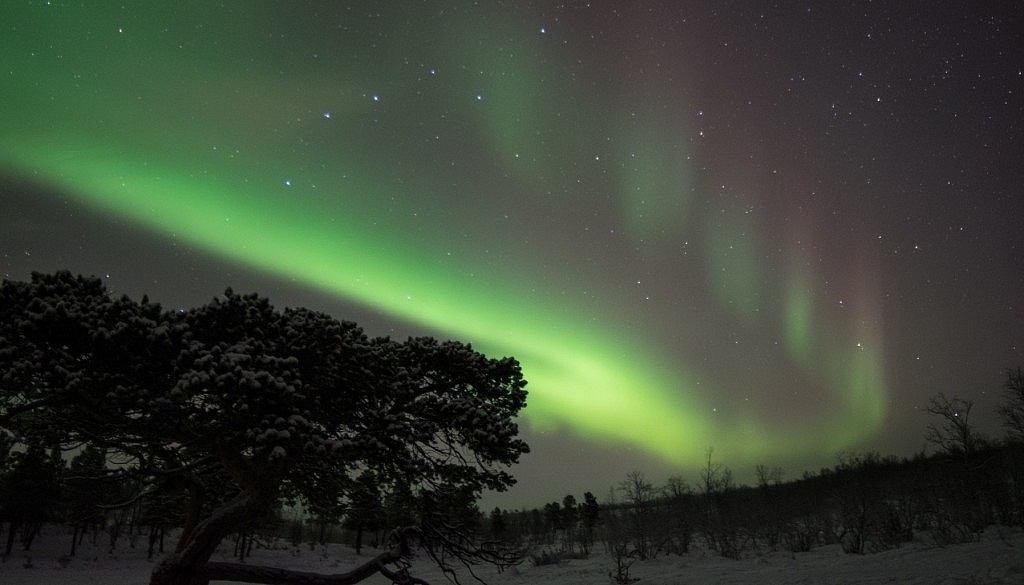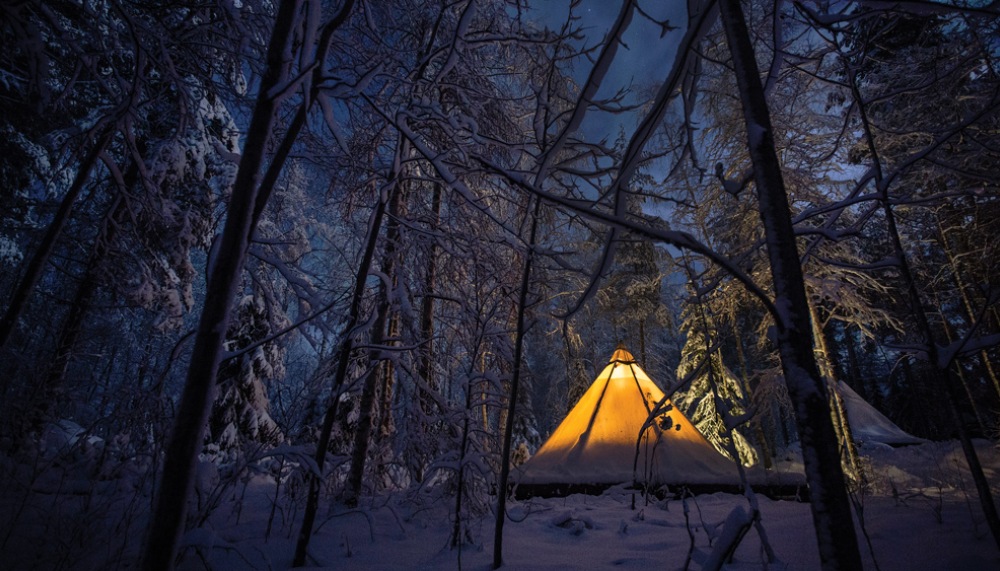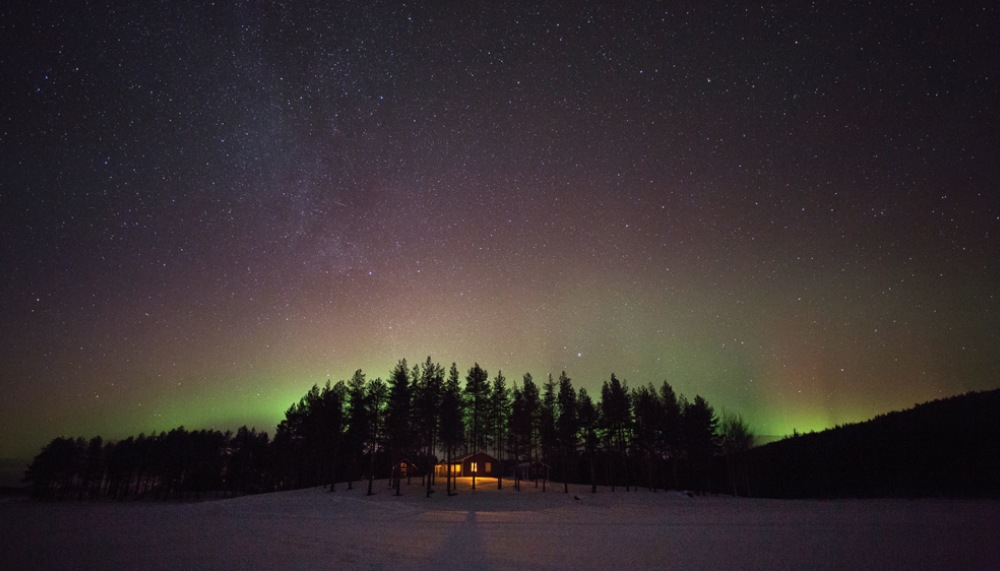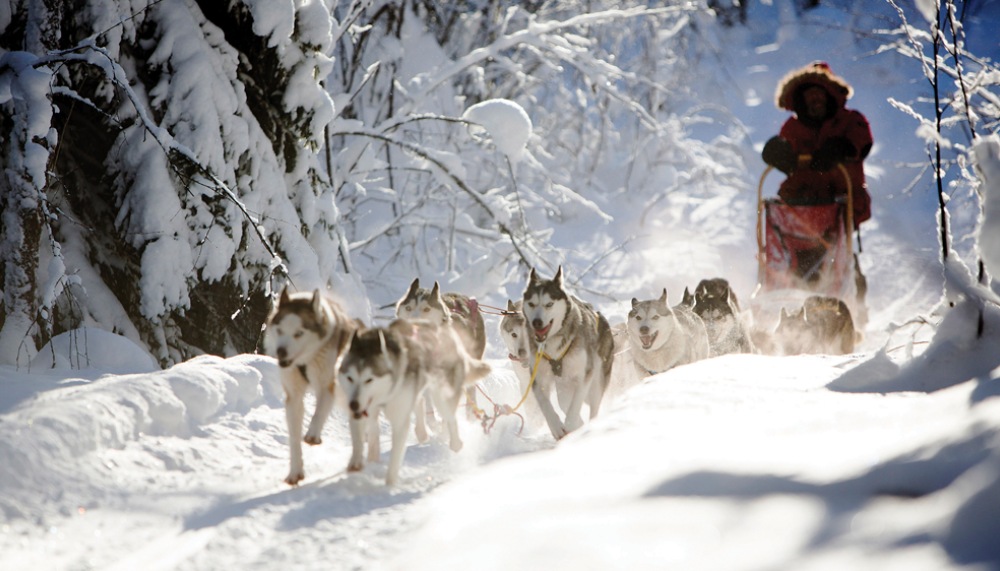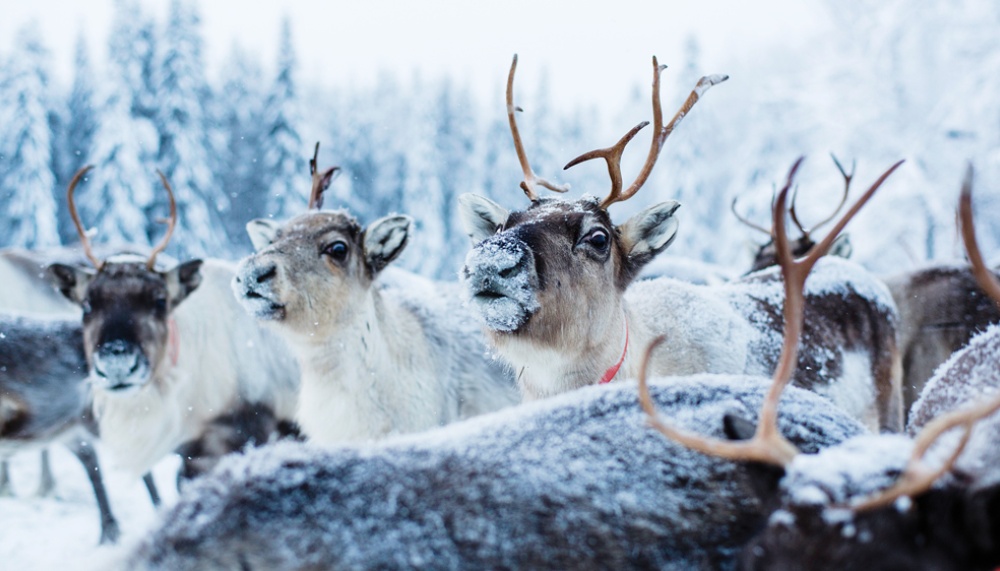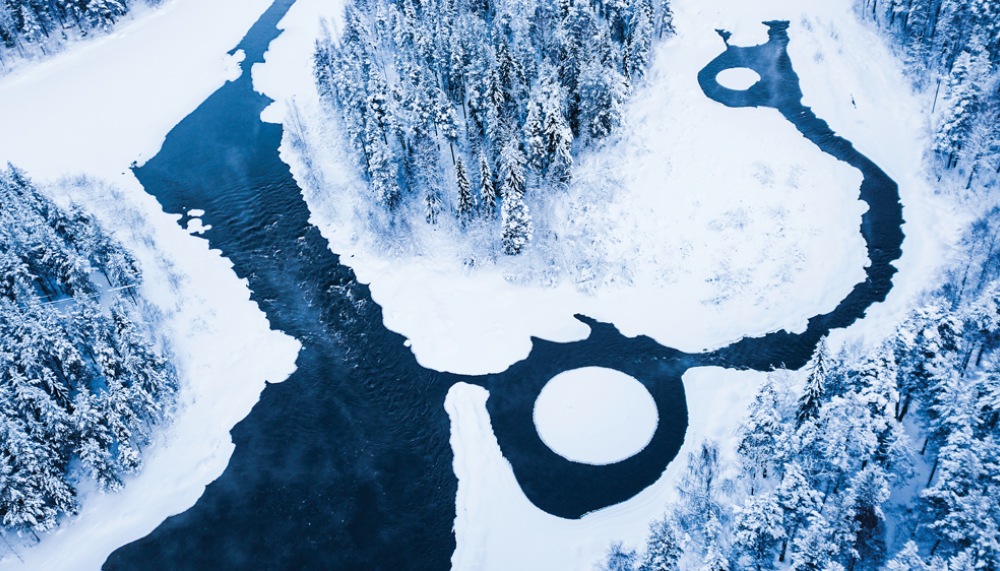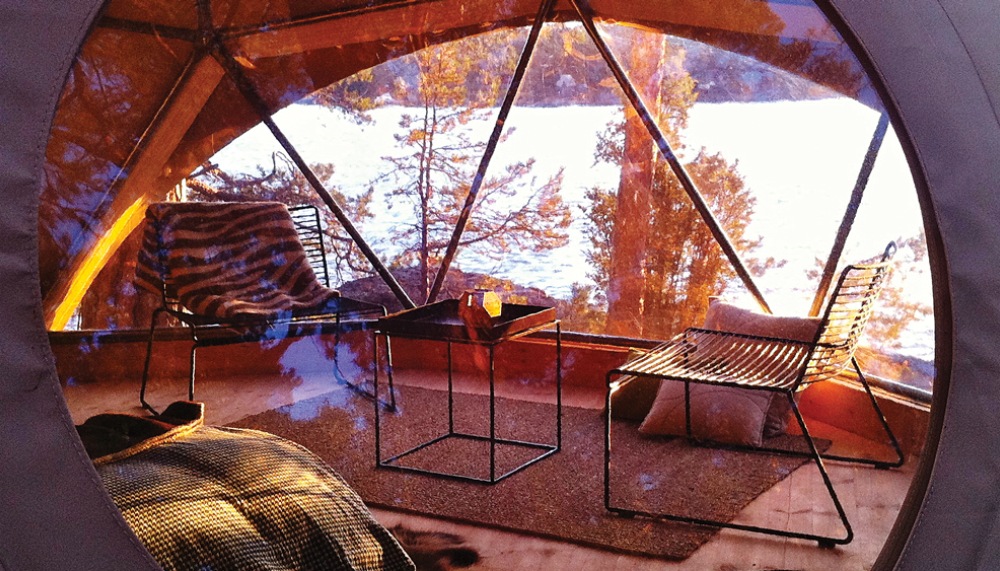Why Your Next Safari Should be in Sweden
It’s 10pm by the time we set out in the speedboat and the sun is still reflecting off the glass-like surface of the Råne River. Jonas Gejke is at the boat’s helm, navigating cautiously through the shallows en route to deeper water. The grizzled safari guide eventually cuts the engine and, surveying the river floor, gives the nod for his first passenger to jump in.
Gejke tosses his passenger a rope that’s dangling from the boat’s stern. Turning back, he grins and hits hard on the engine, its guttural roar leaving a struggling skier in its wake—and prompting a chorus of shrieks, whistles, and laughter from everyone on board.
Such is how you safari in Sweden.
Our group is based at the Aurora Safari Camp, a four-tent-and-one-toilet outpost on the shores of the Råne in Swedish Lapland. Gejke and his business partner, the professional photographer Fredrik Broman, run the camp as part of their Aurora Safaris Sweden, which offers year-round adventures in the wilderness north of Luleå. In summer months their guests hike, fish, kayak and otherwise enjoy the 20-some hours of daily sunlight. In winter—high season in Swedish Lapland—they brave the bitter cold on snowmobiles, skis and dogsleds, and spend the long nights angling for views of the aurora borealis.
In this land of extremes, Gejke is a moderating force. Barrel-chested and grey-bearded, he looks every bit the safari guide: problem solver, survivor, people protector—the kind of person you want around when you’re in the middle of nowhere. His professional pedigree supports such confidence, anchored by his more than two decades running a safari business in Kenya. But it’s here, in his homeland’s far north, where he sees a true frontier.
“It’s gotten to a point where it’s about to explode,” says Gejke, who moved back to Sweden with his Kenyan wife and three children last year to join forces with Broman. “The solitude in the wilderness up here is something that’s completely unique. Fredrik and I, we see opportunities behind every corner. It’s like the Wild West, in a way.”
Gejke and Broman aren’t the only ones who see an up-and-coming safari destination in Sweden. From the northern wilds to the Stockholm Archipelago, modern-day prospectors are mimicking the classic African adventures in an only-in-Sweden style. Unlike in much of sub-Saharan Africa, where the animals are the main attraction on safari, in Sweden it’s the offbeat experiences, seasonal severity, and opportunities for pure, unadulterated fun that draw curious travellers.
Skewing more summer camp than extreme sport, our evening adventure with Aurora Safaris started on the camp’s floating sauna, where Gejke was busy doing everything from baiting our fishing lines to setting out a spread of moose-jerky and reindeer-sausage appetizers. Once we’re on the boat, our outbursts fill the empty river valley, echoing off the dense stands of pines that rise from either shore. Gradually, however, the sun dips below the horizon, our skiing session winds down, and we return to camp in the all-consuming silence of Swedish Lapland.
For all of their adventures in this isolated Arctic region, Aurora’s partners borrow heavily from Gejke’s African playbook. Their remote camp, with its canvas-top accommodations situated around a main dining tent, emulates many of the amenities and activities of its African exemplars—but always with a Swedish slant. Rather than a sundowner on the savanna, for instance, Aurora might stage a Champagne “moonriser” on a bar carved from the ice on a frozen lake. In place of a mokoro trip down a crocodile-infested river, Gejke might take you river rafting on the Råne. Instead of an excursion by elephant back, you might sled across the Arctic Circle behind a team of dogs while wearing a moon suit to keep out the winter cold.
Of course, imitating an African-safari experience in Sweden is not always simple—or possible. The multitasking Gejke is indicative of the challenges outfitters face in a Scandinavian country with high labour costs. “In Africa, running a camp with ten beds you generally have 25 to 40 people doing it behind you,” he says. “Here, you run a camp with twelve beds, and we have two of us.”
The inherent hurdles go beyond just numbers. In a country where most natives are happy taking a tent into the woods, the concept of luxury is relative—and service is far from second nature. Travellers throughout Sweden are often left to haul their own luggage; coffee may or may not be ready when you wake up in the morning; and, except in city hotels, private bathrooms aren’t a priority.
“Most people in Sweden have no concept of what luxury is and what the luxury customer expects,” says Marina Safonova, owner of the Scandinavian tour company Nordic Luxury. “The farther north you go, you can have untouched wilderness all to yourself, but there are no luxury hotels.”
Sweden’s lack of five-star options is not limited to the north—even Stockholm is devoid of marquee international-brand hotels. But the country’s nonconformity is also one of its charms. An adventure through Sweden feels truly Swedish. Rather than standardise your experience, the locals just do what they do normally and hope you like it (even if they some- times seem like they don’t care if you do).
“I share my lifestyle with people who come here, and I get to live in the middle of all this,” says Gejke. “And that’s really what the destination is about. There’s nothing fake about it.”
Torkild Berglund and Kristina Bonde live in the middle of the Stockholm Archipelago, about an hour’s speedboat ride from the Swedish capital. Across a narrow channel from their home, the husband-and-wife team offer their own take on a Swedish safari lodge—and share their own version of the local lifestyle.
Opened in 2012, their eight-tent Island Lodge occupies one of the nearly 30,000 isles in the sprawling archipelago. In the same spirit as Aurora, the lodge was modeled after safari camps in Southern Africa, where Bonde spent much of her childhood.
“It’s a luxury outdoor experience, inspired by the safari concept developed by the Brits in the old days,” says Berglund of the camp, which is open from late spring to early fall. “Pure outdoor luxury— with a bit of hardship.”
That hardship includes shared bathrooms (one each for two sets of four tents) and a do-it-yourself service mentality. But the magic of the Island Lodge lies in its simplicity. The island is more or less yours. (It’s available as either a buyout or a split, with two groups taking the two sides of the camp privately.) Its geodesic-dome tents, which are outfitted with reindeer-skin rugs and wood-burning stoves, are set just off a boulder-strewn shore, where you can sunbathe, swim, or fish for perch from the rocks. And a floating sauna deck— apparently a prerequisite for Swedish safari lodges—offers grab-and-go kayaks and paddleboards, and a jumping-off point for adventures in the archipelago.
My adventures were mostly confined to the island itself, with Berglund bringing me the occasional beer while I swam, paddleboarded, and fished off the sauna deck. At one point he pulled up in his rigid inflatable boat, offering to take me to the other side of the island. A few minutes into our tour, he convinced me to swim to shore, scale a 30-foot (about 91.44 metres) cliff, and leap off.
Back at my tent, I could see and hear Swedish families on an opposite island enjoying their day much as I was enjoying mine—swimming, fishing, jumping off rocks. A speedboat whizzed through the channel, while a sailboat tucked into a nearby cove to drop anchor for the night.
“The wealthiest Swedish people have their own yacht and go out in the archipelago, where they can easily find a small island,” says Berglund. “Experiencing Island Lodge [requires] no skills and no knowledge about the archipelago. Finding an uninhabited island with primeval forest within a one-hour boat ride from the capital—that’s unique.”
Coming upon an isolated stretch in Swedish Lapland is not so novel. Outside of Luleå, a city of some 75,000 residents, pine and birch trees blanket the terrain, broken only by the occasional country house or salmon-filled river. For outsiders, it’s a limitless land of all-enveloping wilderness, endless sunlight in summer, and incomprehensible cold in winter.
“Most people haven’t experienced a proper outdoor winter, and they’re stepping out of their comfort zones doing activities when it’s minus 20 Celsius,” Gejke says. “They think that they’ll never, ever swim in that ice hole in the lake, but they end up doing it anyway.”
“You go there to do things you haven’t done before and see things you haven’t seen before,” says Safonova. “The northern lights—it’s not even a guarantee that you’ll see them, maybe a fifty-fifty chance. But they just keep getting more popular.”
Aurora Safaris is not alone in trying to capitalise on the region’s rising popularity. Last winter, the upstart Arctic Retreat opened outside the village of Gunnarsbyn, about a half hour’s drive from the Aurora Safari Camp. Consisting of a relatively posh pair of cabins and a sauna directly on the Råne River, the exclusive-use property offers a highly civilized base for more vigorous adventures in the surrounding forest.
The Aurora team, too, is adding to the options in Swedish Lapland. Gejke says they plan to launch a mobile safari—involving hut-to-hut skiing, dogsledding, and snowmobiling—next winter. In the meantime, they’re opening the Outpost Lodge, a six-room, all-season hotel set in a converted post office and general store in a village with a population of six.
“It’s at a T-junction,” Gejke says. “Once you pass the junction, there’s nothing. For 150 kilometres, it’s complete and utter wilderness out there. It’s the last stop.”
The sense of isolation Aurora Safaris offers can be more than some guests bargain for. Gejke, after all, can’t be in two places at once, as we soon discover back at camp.
After helping us get settled into our tepee-style tents, each with three simple beds surrounding a wood-burning heater, our guide bids us farewell. He promises to return early the next morning to make coffee and breakfast (and says that if this were winter, he would definitely not be leaving us to fend for ourselves). For now, however, he’s jumping back in his boat and heading home to his family.
As Gejke disappears around a bend, and the putter of his engine fades away, our seclusion sets in. We are alone in the silence and, if only for a few hours, the darkness of Swedish Lapland.
